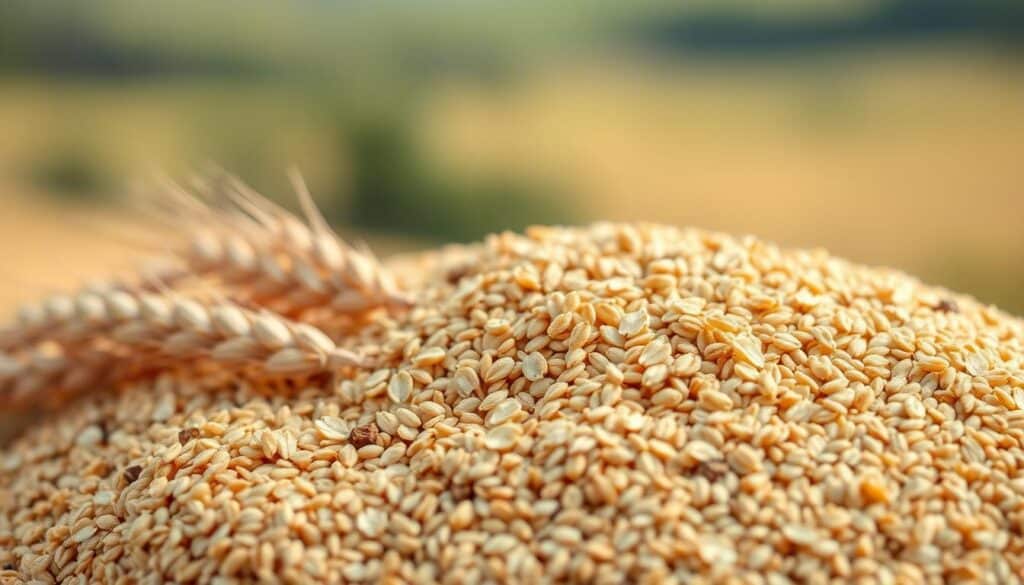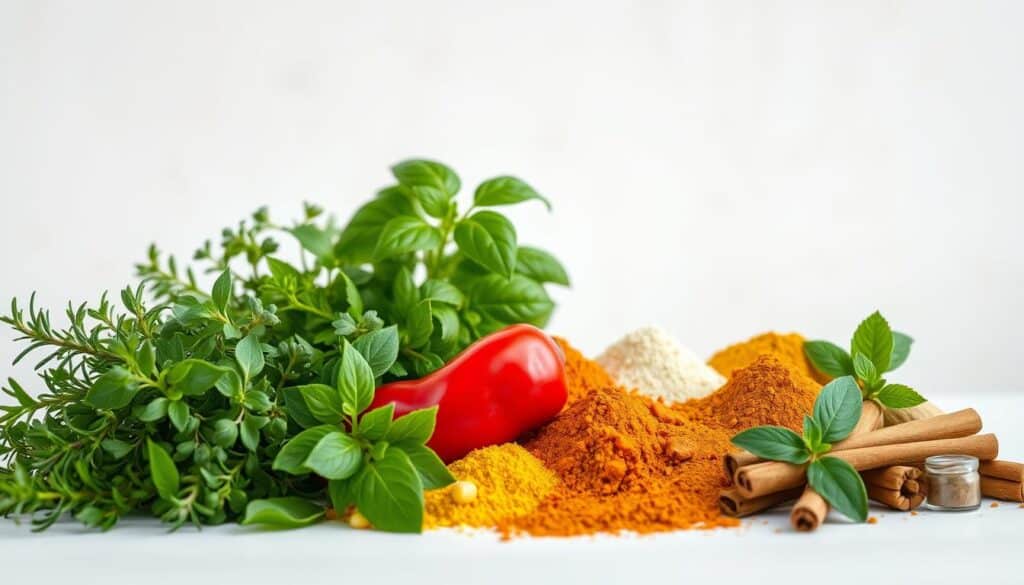This short guide shows which Top Natural Foods for Healthy Blood Pressure work best and how to use them in a practical, everyday way. You will learn foods to lower blood pressure, what a healthy blood pressure diet looks like, and which nutrients—like potassium, magnesium, dietary nitrates, fiber, omega-3s, and bioactive peptides—help regulate circulation and vessel tone.

Hibiscus Tea
The advice here is evidence-based and aligned with major authorities. The American Heart Association’s guidance on sodium and heart-healthy diets, the DASH (Dietary Approaches to Stop Hypertension) trial results, and peer-reviewed findings in journals such as The New England Journal of Medicine and Hypertension back many of these recommendations.
Anúncios
Goals for this article include identifying specific food groups, explaining blood pressure nutrition mechanisms, and offering shopping, cooking, and meal-planning tips you can use in the United States. The target audience is adults seeking dietary strategies to prevent or manage elevated blood pressure, including people on medications who want complementary lifestyle steps. Please consult your clinician before making major changes.
The tone is friendly, practical, and focused on turning scientific evidence into daily meals you can enjoy while supporting heart health.
Anúncios
Key Takeaways
- Focus on whole, minimally processed foods to support healthy blood pressure diet goals.
- Prioritize potassium- and magnesium-rich choices, plus nitrate-containing leafy greens.
- Include omega-3 sources like fatty fish and fiber-rich whole grains for cardiovascular support.
- Follow American Heart Association and DASH guidance on sodium and balanced eating.
- Use shopping and cooking tips to make foods to lower blood pressure simple and affordable.
Top Natural Foods for Healthy Blood Pressure
Choosing whole, minimally processed foods makes a big difference for blood pressure. Natural foods for blood pressure tend to be lower in sodium and added sugars and higher in potassium, fiber, and beneficial bioactive compounds. These traits help keep blood pressure in a healthier range and support weight control, better blood lipids, and lower inflammation.
Processed foods often contain high sodium levels that raise blood pressure. The American Heart Association advises many adults to limit sodium to 1,500–2,300 mg per day. Eating whole foods helps you meet that target while increasing key nutrients for blood pressure control.
Why focusing on natural foods matters for blood pressure
Whole fruits, vegetables, legumes, nuts, seeds, whole grains, lean fish, and low-fat dairy supply the building blocks for better cardiovascular health. Swapping packaged items for homemade meals cuts sodium and boosts potassium magnesium nitrates and fiber intake. That combination eases strain on blood vessels and supports healthy circulation.
Overview of nutrients that help regulate blood pressure
Potassium helps counteract sodium and relaxes vessel walls. Good sources include bananas, potatoes, leafy greens, and beans. Magnesium supports vascular tone and endothelial function and is found in nuts, seeds, whole grains, and leafy greens.
Dietary nitrates convert to nitric oxide, which promotes vasodilation. Leafy greens like spinach, arugula, and beetroot are rich in nitrates. Omega-3 fatty acids from salmon, mackerel, and flaxseed reduce inflammation and may modestly lower blood pressure.
Fiber aids weight and glycemic control and supports vascular health; find it in whole grains, fruits, vegetables, and legumes. Low-fat dairy provides calcium and bioactive peptides linked to small blood pressure benefits. Together, these nutrients for blood pressure control form a practical nutritional foundation.
How to use this list in a weekly meal plan
Prioritize at least five servings of fruits and vegetables daily. Include 2–3 servings of oily fish per week. Choose whole grains at each grain-based meal. Keep nuts or seeds handy for snacks and replace high-sodium processed items with homemade versions.
Try simple swaps: canned soup for low-sodium homemade bean and vegetable soup, white rice for brown rice or quinoa, and salty chips for unsalted almonds or fresh fruit. A basic grocery list might include leafy greens, berries, bananas, beans, whole grains, olive oil, garlic, low-fat yogurt, salmon, and almonds.
When following meal planning for hypertension, check with your clinician if you take blood pressure medications. Higher potassium intake can interact with ACE inhibitors, ARBs, and potassium-sparing diuretics. Adjustments from a healthcare provider ensure safety while you improve diet and health.
Fruits That Help Lower Blood Pressure
Fruits deliver potassium, fiber, vitamin C, and polyphenols that support healthy blood vessels. Eating whole fruit in place of salty snacks can help reduce blood pressure over time. Aim for one to two servings of fruit with meals or snacks and favor whole fruit over juice to keep fiber and steady blood sugar.
Berries bring potent antioxidants that protect arteries and ease strain on the heart. Blueberries, strawberries, and raspberries contain anthocyanins and polyphenols linked to better endothelial function. Randomized trials and population studies report modest drops in blood pressure after regular berry intake.
Try adding berries to oatmeal, Greek yogurt, smoothies, or salads. Keep frozen berries on hand for year-round access. These simple swaps help you tap into the benefits of berries blood pressure studies highlight.
Bananas and potassium-rich fruits are key for balancing sodium and easing vascular tension. A medium banana has about 420 mg of potassium. Other potassium-rich fruits include cantaloupe, honeydew, kiwi, oranges, apricots, and prunes.
Aim for roughly 3,500–4,700 mg of potassium daily from food unless a clinician advises otherwise because of kidney disease. Snack ideas include a banana with nut butter or sliced kiwi in a small fruit salad to boost intake of potassium-rich fruits.
Citrus fruits and vitamin C support dilation of blood vessels through flavonoids and vitamin C. Oranges, lemons, limes, and grapefruits add bright flavor while helping vascular function. Use citrus segments in salads, squeeze lemon on roasted vegetables, or enjoy orange slices as a quick snack.
Be mindful that grapefruit can interact with statins and certain blood pressure medicines. Check with a pharmacist or physician before making grapefruit part of a daily routine. Incorporating citrus vitamin C blood pressure sources safely helps round out a heart-friendly fruit plan.
Vegetables to Include Daily for Better Blood Pressure
Vegetables supply key nutrients that help keep blood pressure in check. Aim for color and texture variety to get nitrates, potassium, magnesium, fiber, and antioxidants each day. A simple goal is 2–3 cups of vegetables daily as part of a heart-friendly eating pattern.
Leafy greens and nitrate content
Spinach, arugula, kale, Swiss chard, and romaine are rich in dietary nitrates. Those nitrates convert to nitric oxide, which relaxes blood vessels and may lower systolic pressure. Add raw spinach to smoothies, toss arugula into salads or on pizza, and sauté kale as a quick side.
Cruciferous vegetables and overall cardiovascular health
Broccoli, Brussels sprouts, cauliflower, and cabbage bring fiber, vitamin K, and glucosinolates linked with better arterial function. Roast or steam them to preserve nutrients. Toss with garlic and olive oil for flavor without extra salt.
Root vegetables with potassium and fiber
Potatoes with skin, sweet potatoes, beets, carrots, and turnips are solid sources of potassium and fiber. Beets supply both nitrates and earthy sweetness. Prefer baking or roasting over frying, and season with herbs and lemon instead of salt.
| Vegetable Group | Key Benefits | Simple Serving Ideas |
|---|---|---|
| Leafy greens | High in leafy greens nitrates; supports nitric oxide production and vasodilation | Spinach smoothies, arugula salads, sautéed Swiss chard |
| Cruciferous | Cruciferous vegetables heart health: fiber, vitamin K, glucosinolates for arteries | Roasted broccoli, steamed cauliflower, pan-seared Brussels sprouts with garlic |
| Root vegetables | Root vegetables potassium and fiber; beets add extra nitrates | Baked sweet potato, roasted carrots, beet and orange salad |
Whole Grains and Their Role in Blood Pressure Control

Whole grains pack the bran and germ that refined grains lose. That means fiber, magnesium, potassium, and phytonutrients that help weight control, insulin sensitivity, and healthy blood vessels. Randomized trials and long-term studies link whole grains blood pressure benefits to regular intake.
Why whole grains beat refined grains
Refined options like white bread and white rice lack fiber and can raise blood glucose after meals. Those spikes may promote weight gain and raise risk for high blood pressure over time. Choosing whole grains slows digestion and steadies blood sugar, which supports lower blood pressure.
Best whole grains to add to meals
Oats deliver beta-glucan fiber that helps cholesterol and may ease oats hypertension risk. Brown rice brings fiber and minerals linked to improved brown rice blood pressure markers. Quinoa supplies a complete plant protein and magnesium, making quinoa heart healthy for many diets.
Other solid picks include barley, farro, bulgur, and whole-wheat products. For those with celiac disease or gluten sensitivity, quinoa and brown rice are safe, nutrient-dense choices.
Simple recipe ideas with whole grains
Start the day with overnight oats topped with berries and flaxseed for a potassium- and fiber-rich breakfast.
Try a quinoa salad with spinach, chickpeas, cucumber, and lemon-olive oil dressing for a light lunch that supports heart health.
Make a brown rice bowl with salmon, roasted vegetables, and avocado for a balanced dinner that pairs whole grains with healthy fats and protein.
Swap in a quick barley or farro pilaf seasoned with herbs and garlic as a versatile side dish. For smooth transitions, replace white rice with brown rice 1:1, mix whole-grain and regular pasta, or use oats to thicken smoothies and savory porridges.
Lean Proteins That Support Healthy Blood Pressure
Choosing the right protein helps keep blood pressure in check and supports overall heart health. Lean animal options and plant-based choices lower sodium and saturated fat intake. That helps with weight control and long-term blood pressure management.
Fish high in omega-3s and blood pressure effects
Fatty fish such as salmon, mackerel, sardines, trout, and herring supply EPA and DHA. These omega-3s reduce inflammation and may lower systolic readings by a few points when eaten regularly. The American Heart Association suggests about two 4-ounce servings of oily fish each week.
Bake, grill, or broil with lemon and herbs rather than frying. Choose low-sodium canned wild salmon or sardines for a quick, nutrient-rich option. These steps boost omega-3 fish blood pressure benefits without adding excess salt.
Poultry and plant-based protein choices
Skinless chicken and turkey are versatile, lean proteins that fit into low-sodium meal plans. Swap processed deli meats for grilled chicken breast to cut sodium and additives linked to higher blood pressure.
Legumes, tofu, tempeh, and edamame provide fiber, potassium, and magnesium. These nutrients help regulate blood pressure and reduce reliance on animal sources. Emphasizing plant-based protein hypertension strategies can lower risk while offering varied textures and flavors.
How much protein to aim for daily
Most adults meet needs with 0.36–0.6 grams per pound of body weight. Older adults and active people may aim for 0.45–0.8 g per pound. Spread intake across meals to support steady blood sugar and satiety.
Target about 20–30 grams of protein per meal. Practical portions include 3–4 ounces cooked fish or poultry and 1/2–1 cup cooked beans. This approach aligns protein intake heart health goals with real-world servings.
| Protein Source | Typical Serving | Key Nutrients | Why it helps blood pressure |
|---|---|---|---|
| Salmon (wild) | 3–4 oz cooked | EPA/DHA, protein, vitamin D | Omega-3s reduce inflammation and modestly lower systolic pressure |
| Sardines (canned, low-sodium) | 3 oz | Omega-3s, calcium, protein | Convenient source of omega-3 fish blood pressure support |
| Skinless chicken breast | 3–4 oz cooked | Lean protein, B vitamins | Low in saturated fat; better than processed meats for blood pressure |
| Black beans | 1/2 cup cooked | Fiber, potassium, magnesium, protein | Supports vascular health and reduces plant-based protein hypertension risk |
| Tofu | 1/2 cup firm | Protein, calcium, iron | Low-sodium preparation adds lean protein without extra salt |
| Edamame | 1/2 cup cooked | Protein, potassium, magnesium | Plant protein that supports blood pressure and satiety |
Nuts, Seeds, and Healthy Fats for Blood Pressure Management
Small servings of nuts, seeds, and plant fats give the body unsaturated fats, magnesium, potassium, fiber, and plant sterols. These nutrients support healthy blood vessels and can help with modest reductions in blood pressure when eaten regularly as part of a balanced diet.
Almonds, walnuts and heart-focused nutrients
Choose unsalted nuts to avoid excess sodium. A one-ounce handful of almonds or walnuts makes a filling snack and helps control portions. Almonds provide magnesium and vitamin E, while walnuts deliver alpha-linolenic acid linked to improved vascular function.
Try sprinkling chopped almonds or walnuts on oatmeal, yogurt, or salads for crunch and a nutrient boost that supports almonds walnuts heart health.
Flaxseed and chia for omega-3 and fiber
Ground flaxseed and whole chia seed add soluble fiber and plant-based omega-3s. Two tablespoons of ground flaxseed mixed into a smoothie or yogurt is easy to absorb. Chia seeds make quick puddings or thicken batters without changing flavor.
Regular use of flaxseed and chia supports blood lipid balance and offers modest improvements tied to flaxseed chia omega-3 benefits.
Using olive oil and avocados in cooking
Extra-virgin olive oil shines as a dressing or low-heat cooking fat because of its monounsaturated fats and polyphenols. Avocado adds creamy texture, potassium, and fiber when swapped for high-sodium spreads.
Dress a salad with olive oil, add sliced avocado to sandwiches, and aim for mindful portions to leverage olive oil avocado blood pressure advantages without excess calories.
Practical tips
- Stick to about one ounce of nuts per day to gain benefits without extra calories.
- Choose raw, unsalted nuts and unflavored seeds to avoid added sugar and salt.
- Use ground flaxseed for better absorption and rotate between seeds for variety.
- Use olive oil for dressings and low- to medium-heat cooking; add avocado as a spread alternative.
Dairy and Dairy Alternatives That May Help Lower Blood Pressure
Include a reliable dairy or fortified plant milk in meals to support blood pressure goals. Low-fat milk, plain Greek yogurt, and some cheeses supply calcium, vitamin D when fortified, and proteins that can affect vascular health. Plant choices such as soy, almond, and oat milk vary in nutrients, so smart shopping matters when choosing dairy products for a heart-healthy pattern.
Low-fat dairy benefits
Low-fat dairy blood pressure effects come from calcium, potassium, and bioactive peptides in milk proteins. The DASH diet highlights low-fat milk and yogurt as part of a lower hypertension risk pattern. Plain, low-fat Greek yogurt gives added protein with less sugar and works well in breakfasts, dressings, and dips.
Plant milks and fortified alternatives
Milk alternatives fortified calcium matters because many plant milks lack natural dairy calcium. Choose unsweetened versions of soy, almond, or oat milk that list about 300 mg calcium per cup and added vitamin D. Soy milk tends to offer more protein than almond or oat varieties, which may help keep meals balanced.
How to choose at the store
When choosing dairy products, read labels for sodium, added sugars, calories, and fortification. For cow’s milk pick low-fat or fat-free if you follow DASH-style advice. For alternatives, favor unsweetened, fortified options and check that a serving equals roughly 8 ounces for milk or 6–8 ounces for yogurt.
Consider lactose-free cow’s milk or fortified plant milks if lactose intolerance is a concern. Keep portion sizes consistent and swap plain yogurt for sugary varieties to capture yogurt blood pressure benefits without excess sugars.
Herbs and Spices That Can Naturally Support Blood Pressure

Fresh herbs and pantry spices can lift taste while helping reduce reliance on salt. Many contain active compounds that support vascular health, making herbs spices blood pressure an easy focus for everyday cooking.
Garlic shows promise for people with elevated numbers. Clinical trials of fresh garlic and aged garlic extract report modest drops in both systolic and diastolic readings. For those monitoring garlic hypertension, adding minced garlic to dressings, sautés, and marinades is a practical step.
Turmeric delivers curcumin, an anti-inflammatory compound linked to improved endothelial function. Combining turmeric with black pepper and a bit of healthy fat boosts turmeric blood pressure benefits. Stir turmeric into soups, eggs, or smoothies for low-effort gains.
Cinnamon brings warm flavor and metabolic perks. Using cinnamon salt-free flavoring can cut salt use while supporting blood-sugar balance. Sprinkle Ceylon or Cassia cinnamon on oatmeal, roasted squash, or in spice rubs to lower the urge for added sodium.
Other salt-free options include rosemary, thyme, oregano, basil, smoked paprika, cumin, and coriander. Citrus zest brightens dishes so salt feels less necessary. A pantry of these choices makes it simple to build flavorful, lower-sodium meals.
Practical habits help you adapt taste gradually. Start by replacing half the usual salt with herb blends, then reduce more as flavors settle in. Make a basic rub with garlic, lemon, olive oil, and chopped herbs for meats and vegetables.
Try these easy ideas: add crushed garlic to vinaigrette, whisk turmeric into yogurt with a pinch of black pepper, and dust cinnamon over yogurt or roasted sweet potatoes. Small, consistent shifts in seasoning habits support long-term change without sacrificing enjoyment.
Beverages That Promote Healthy Blood Pressure
Choosing the right drinks can support heart health and help manage beverages blood pressure naturally. Small swaps and mindful hydration make a real difference for people watching their numbers.
Water intake and its importance
Adequate hydration supports circulation and kidney function, two key factors in blood pressure control. Many adults aim for about 2–3 liters daily, adjusted for activity, climate, and medical advice.
Drinking water instead of sugary drinks lowers calories and can help with weight loss, which often improves water hypertension outcomes. People with heart failure or advanced kidney disease should follow clinician guidance on fluid limits.
Green tea, hibiscus, and beneficial compounds
Green tea contains catechins that may modestly improve vessel function. Regular unsweetened brews can be a smart addition to a blood-pressure-friendly routine.
Hibiscus tea shows stronger evidence for lowering systolic readings in short-term trials. Studies suggest 1–3 cups of brewed hibiscus daily may help people with stage 1 hypertension when taken without added sugar.
To maximize benefits, prepare teas at home, skip bottled versions high in sweeteners, and monitor personal response. These choices contribute to green tea hibiscus blood pressure improvements when combined with healthy habits.
Drinks to avoid: alcohol, sugary beverages, and excess caffeine
Alcohol raises blood pressure when consumed excessively. Follow U.S. guidelines of up to one drink per day for women and up to two for men, or reduce intake if blood pressure is uncontrolled.
Sodas, sweetened juices, and energy drinks promote weight gain and higher readings. Swapping them for water or unsweetened options cuts calories and limits drinks to avoid high blood pressure.
Caffeine affects people differently. Moderate amounts are usually acceptable, yet large doses or sensitivity can cause temporary spikes. Track how coffee and energy drinks influence your own readings.
Practical swaps include sparkling water with lemon, iced unsweetened green tea, or brewed hibiscus instead of sweet tea. These simple switches reduce risks tied to beverages blood pressure while keeping flavor and variety in your daily routine.
Diet Patterns That Amplify the Benefits of These Foods
Choosing a clear eating pattern helps the foods in earlier sections work better for your heart. Two well-studied approaches—the DASH plan and the Mediterranean way—share many strengths. Both center on plants, whole grains, lean protein, nuts, and healthy fats. They cut back on processed foods and excess salt to support healthy blood pressure and overall cardiovascular health.
Overview of DASH and Mediterranean diets
The DASH diet focuses on fruits, vegetables, whole grains, low-fat dairy, lean proteins, and nuts while limiting sodium. Clinical trials show DASH diet blood pressure reductions in both systolic and diastolic readings. The Mediterranean approach emphasizes olive oil, legumes, vegetables, fish, nuts, and moderate wine. Studies link the Mediterranean diet hypertension benefits to fewer cardiovascular events and better blood-pressure control.
How to transition to a heart-healthy eating pattern
Start with small, practical swaps to make change stick. Cut processed snacks and added salt. Add a vegetable to at least one meal each day. Replace white bread and pasta with whole-grain versions. Aim for one extra fish serving weekly and choose unsalted nuts for snacks.
Take a gradual path. Change one mealtime each week. Try Mediterranean-style breakfasts with fruit, yogurt, and olive oil toast, then adopt DASH-style dinners rich in vegetables and low-fat dairy. Use frozen fruits and vegetables when fresh produce is hard to find. Batch-cook grains and beans to ease weeknight pressure.
Meal-planning tips for busy lifestyles
Simple templates keep meals balanced and fast. Breakfast: whole grain, fruit, and low-fat yogurt or plant milk. Lunch: salad or grain bowl with a protein and vegetables. Dinner: fish or poultry or a plant protein with two vegetables and a whole grain.
Batch cook rice, quinoa, and beans on the weekend. Prep mason-jar salads and pre-chopped vegetables for quick grabs. Sheet-pan dinners—salmon, mixed vegetables, olive oil, and herbs—save time and limit added salt. A short grocery list helps: frozen berries, frozen salmon fillets, canned low-sodium beans, brown rice or quinoa, spinach or kale, garlic, olive oil, nuts, and low-fat yogurt.
Shopping and Cooking Tips for Blood Pressure-Friendly Meals
Smart shopping and simple cooking keep meals tasty and heart-friendly. Use small steps to lower sodium, save time, and stretch your food budget while eating well.
How to read labels for sodium and additives
Always check the serving size before you judge a package. Look at sodium per serving and aim for items with less than 140 mg per serving when possible. Scan the percent Daily Value for sodium to compare products quickly.
Know common hidden sources of salt: canned broths, deli meats, condiments, and packaged sauces. Choose labels that say “low sodium” or “no salt added.” Rinse canned beans to cut sodium further.
Read ingredient lists. Shorter lists with familiar words are better. Watch for terms like monosodium glutamate or baking soda, and avoid hydrogenated oils and added sugars.
Batch cooking and smart substitutions
Cook staples in bulk to save time on weeknights. Make large pots of brown rice or quinoa, roast a tray of vegetables, and grill or bake lean chicken breasts for easy bowls.
Try time-saving methods such as sheet-pan dinners, slow-cooker soups made with low-sodium broth and dry beans, or one-pot grain bowls. These cut prep and cleanup time.
Swap for lower-sodium and healthier options: Greek yogurt in place of sour cream, mashed avocado instead of mayonnaise, and herbs and spices instead of extra salt. Make homemade tomato sauce rather than using high-sodium jarred marinara. Use unsalted nuts for snacks instead of chips.
Budget-friendly choices for healthy eating
Frozen fruits and vegetables offer the same nutrients as fresh and last longer. Buy whole chicken to portion and roast at home. Purchase dry beans and bulk whole grains for big savings.
Shop seasonal produce and compare unit prices. Store-brand low-sodium versions often cost less and taste similar to name brands. Plan meals like lentil soup, bean chili, and vegetable stir-fries with brown rice to stretch ingredients.
Here is a quick comparison to help pick pantry staples:
| Pantry Item | Low-Sodium Option | Cost-Saving Tip |
|---|---|---|
| Canned Beans | No salt added; rinse after draining | Buy dry beans in bulk and soak/cook at home |
| Broth | Low-sodium or homemade broth | Make broth from roasted vegetable scraps and chicken bones |
| Tomato Sauce | Homemade or low-sodium jar | Use canned crushed tomatoes and season yourself |
| Snacks | Unsalted nuts or air-popped popcorn | Buy large bags and portion at home |
Use these shopping tips low sodium to guide purchases, read nutrition labels sodium to compare items, practice batch cooking healthy for busy weeks, and focus on budget-friendly healthy food to keep both your wallet and blood pressure in better shape.
Conclusion
This guide shows that building meals around whole fruits and vegetables, whole grains, lean proteins, nuts and seeds, low-fat dairy or fortified alternatives, herbs and spices, and blood-pressure-friendly beverages can meaningfully support healthy blood pressure. The natural foods for healthy blood pressure conclusion is simple: consistent, nutrient-rich choices matter more than perfect rules. Small swaps add up.
To summarize blood pressure diet tips, begin with one or two actionable steps hypertension diet changes: reduce processed foods and added salt, add a daily serving of leafy greens, and aim for at least one serving of fatty fish per week. Use a simple weekly meal plan and the shopping and cooking strategies described earlier to make these changes practical and affordable.
Before making major changes, consult your healthcare provider, especially if you have kidney disease, take blood pressure medications, or use ACE inhibitors/ARBs, which can interact with high-potassium diets. Be aware of specific drug-food interactions such as grapefruit with certain medicines and ask a registered dietitian for personalized guidance when needed.
Small, consistent dietary changes can lead to meaningful improvements in blood pressure and heart health. Use DASH meal templates, American Heart Association guidance, or a dietitian to create a personalized plan. Keep changes simple, track progress, and celebrate steady wins along the way.



